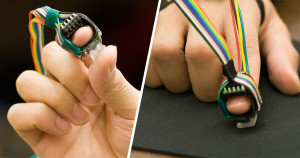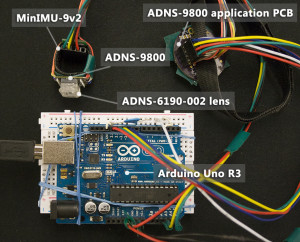I am proudly releasing my video demonstrating a 3D input device that I built for my Master’s thesis: 3DTouch.
This is a novel 3D wearable input device, worn on the fingertip for 3D manipulation tasks. 3DTouch is self-contained, and designed to universally work on various 3D platforms. The device employs touch input for the benefits of passive haptic feedback, and movement stability. On the other hand, with touch interaction, 3DTouch is conceptually less fatiguing to use over many hours than 3D spatial input devices. Modular solutions like 3DTouch opens up a whole new design space for interaction techniques to further develop on.
The paper is available here: http://arxiv.org/abs/1406.5581
This device was built using an Arduino Uno R3, a 9DOF inertial measurement unit MinIMU-9v2, and an laser optical sensor ADNS-9800. The software was developed mainly in Vrui framework.
Motivation behind the design
There are a wide variety of 3D input devices from stationary desktop settings to spatial environments such as large wall-displays and the CAVEs. Desktop input devices such as mouse, joystick, touch-pads… possess high precision and responsiveness due to a supporting surface, and incur less fatigue than spatial mid-air input devices like Wiimote or Kinect. However, these desktop devices are not mobile, and can only support relative positioning.
In spatial environments, tracking input devices such as Kinect, OptiTrack, RazorHydra support absolute positioning; however, they require a base reference. Moreover, interaction enabled by these devices is fatiguing. GPS tracking devices support absolute positioning; and are self-contained! However, their accuracy is within feets, not usable for room-sized tracking volume.
With the explosion of 3D applications in everyday life across various 3D platforms, it is necessary to have a self-contained 3D input device that allows user to interact with 3D applications anytime, anywhere! And this device needs to incur less fatigue than mid-air gestures in order for users to practically use over a long time (i.e.: 8 hrs/ workday).
The particular benefits of our design are:
- 3DTouch is modular, for example, users can wear 2 pieces of the device, each on an index finger to enable multi-touch interaction.
- 3DTouch is flexible, supporting multiple form factors. This allows users to wear the device at his comfort finger position, depending on specific interaction techniques.
- 3DTouch is wearable opening up a whole new design space for interaction techniques. Examples: 1) in the CAVE, with 3DTouch worn on the index finger, users can use the palm of the other hand as the touch surface; 2) Two fingers wearing two pieces of 3DTouch would enable multi-touch interaction; 3) 3DTouch users can interact with curved surfaces!


